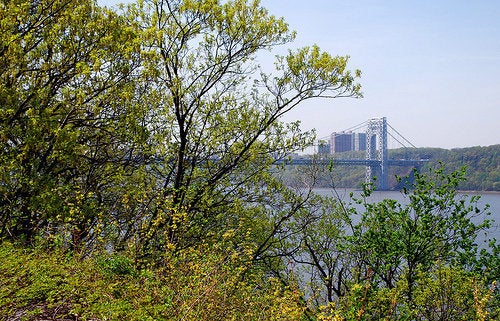
Although it is one of America's most beautiful and historic waterways, the Hudson River has had some ups and downs over the past 400 years. Visitors to the New York Historical Society recently had occasion to recall how the fortunes of the river have changed since 1609 -- the year of Henry Hudson's voyage of exploration in the Half Moon -- when former New York Governor George E. Pataki and New York Times environmental reporter Andrew Revkin joined us at our annual Weekend with History event for a talk about the Hudson. As these speakers reminded us, the Hudson River has played a decisive role, not only as the birthplace of New York City and State, but also as the cradle of today's environmental movement.
From the establishment of New Amsterdam at the mouth of the Hudson to the extension of the river's trade into the West through the Erie Canal, the wealth and vitality of New York were founded on the commerce and industry that flowed along the Hudson. By the early 19th century, this same commerce and industry was filling the riverbank with factories, docks and ferries. Even in those early days, progressive citizens and reformers such as the poet and newspaper editor William Cullen Bryant recognized the threat posed to the river and its landscape by unchecked development and industrial pollution, and they tried to do something about it.
One of their most enduring achievements in this regard was to promote the image of the Hudson River Valley as an Eden rediscovered in America -- a natural landscape still imbued with a divine glow that was lost to the Old World. Unspoiled nature became a national ideal -- even though the greatest creators of this ideal, the painters of the Hudson River School, were fully aware of the economic role of the Hudson.
In their canvases, these painters acknowledged but did not foreground economic development and its inevitable impact on the landscape. Instead, as may be seen in the Historical Society's exceptional collection of Hudson River School paintings (soon to be exhibited at the Samuel Dorsky Museum of Art at SUNY New Paltz, opening July 11), these artists would slip a commercial or industrial site into a corner of the picture. Historical Society senior art historian Linda Ferber notes that these traces of modern activity were "so deftly naturalized that today we may overlook the evidence of extractive industries, the impact of the railroad, real estate development, and the tourist business."
And so the Westchester riverbanks celebrated in paintings by Robert Havell and Asher B. Durand hint at their development for steamboat and later railroad service. Andrew Bunner's winter view of Rockland Lake shades in the seasonal industry of cutting and storing ice for later shipment to New York City. William Miller's picturesque vista of the Bronx River at West Farms is lined with mill and factory buildings; and Joseph Volmering's sweeping panorama of the Tappan Zee includes a view of the state prison built at Sing Sing (today's Ossining) to provide convict labor for the nearby marble quarries.
At least in a painting, the presence within nature of industry, and even criminality, could be reconciled with the Edenic vision. No such accommodation could be made for cholera. As the 20th century began, New York State recognized the link between environmental degradation and disease when it created a Department of Health, charged (among other duties) with investigating epidemics caused by "overflow of the canals," and a Water Supply Commission charged with reviewing water quality and methods of sewage disposal. A concerted effort to clean up the State's waters -- including those of the majestic Hudson -- began here, with this public health campaign.
But it was industrial pollution that at last prompted the public to go beyond a concern with the safety of its drinking water, to demand stewardship of the waterways for their own sake. By the 1960s, the American vision of unspoiled nature, now more than a century old, was helping to inspire a popular movement.
Looking back, it's possible to identify any number of turning points for this movement. As Andrew Revkin pointed out during Weekend With History, one of these was a landmark court decision in 1965 in favor of the Scenic Hudson Preservation Conference, permitting this citizens' group to sue Consolidated Edison to block a building project at Storm King Mountain, and ruling that the Federal Power Commission had to consider the proposed plant's impact on the "unique beauty and historic significance" of the Hudson River Valley. Another such moment was the disaster of July 1, 1976, when a barge struck the Tappan Zee Bridge and spilled 50,000 gallons of oil into the Hudson -- an event that galvanized efforts to restore the river.
And as Governor Pataki reminded us at the Historical Society, a different kind of disaster also contributed indirectly to the environmental drive. The collapse of the West Side Highway in 1973 led eventually (after many political skirmishes) to the establishment during his administration of the Hudson River Park Trust, which over the past ten years has created the magnificent Hudson River Park on the far West Side of Manhattan. As Governor Pataki noted, this park has drawn many New Yorkers to the water's edge for the first time. The more they see of an increasingly cleaned-up Hudson River, the more they want the clean-up to continue.
Four hundred years after Henry Hudson's voyage, people are still discovering the Hudson River for themselves -- and what they see still inspires them.
